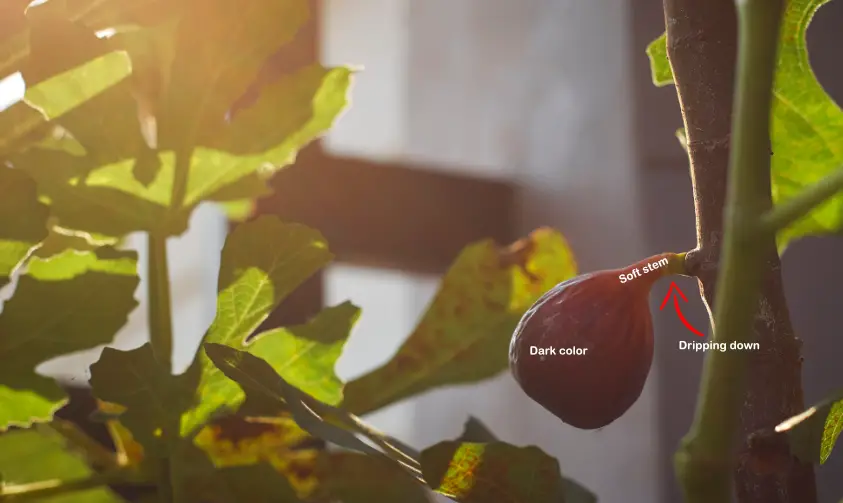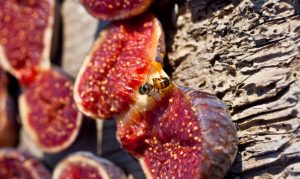There are different ways to know when a fig is ripe. Looking for cracks on the skin, the softness of the fig neck and the dark color of the fruit are great indicators that they’re ready to be picked off.
Let’s look at them in detail.

Contents
When to pick figs?
Plucking a ripe fig off the tree can be a difficult task to do if you don’t know the right way. With all of the different figs, it is easy to get confused and pick a green fig that will make your mouth sore. In this section, you will learn how to pick ripen figs off the tree.
Green figs that are hard are not ripe. Green figs also contain fig sap which can cause blisters in your mouth too.
You can tell a fig is ripe by looking at it. Cracks on figs and the softness of the fig neck are good indicators that the fig has ripened. If the fig is dripping down then it also shows that the fig is ripe. Also, the fig looks dark in color if it has ripened.
If you are not sure, pick one of each kind (this works with any variety of figs). The one you think is ripest will usually be the best tasting.
The inside of a fig looks amber or red in color depending on the variety and it may also have a honey-like fluid dripping from it.
So to conclude, the best way to tell if a fig is ripe is by touching the neck of the fig, if it is soft then the fig is ripe and ready to be picked off the tree.
Note: Figs don’t continue to ripen after being picked. So make sure to pick the figs when they fully ripen.
How long does it take for figs to ripen?
Most people can’t wait to taste a ripe fig fresh off the tree, but many don’t know how long it takes for them to grow into an edible fruit!
It can take anywhere from one year up to five years before a fig is ready for harvest time.
There are two types of fig trees that you can choose from. The first is called common figs and the other is a Smyrna fig tree. The Smyrna type of fig is considered a “true” fig and they are ready for harvest in one year.
In the year that it takes for a common fig tree to grow and be ready to harvest, the tree will produce three crops of flowers. The first crop will be pollinated by hand. After that, the tree will begin to produce figs. Once the figs are ripe (or “non-ripe”), they will fall to the ground.
Research has shown that most fig trees need about four years to produce one crop of figs. However, there are some varieties that need a little longer before they bear fruit. If you want to have figs that are bigger, then you will need to wait about six years.
Do you know the reasons why figs won’t ripe?
- Fig tree’s roots are shallow, and require lots of water to be able to grow and ripen its fruit. If the fig tree doesn’t get enough water, it will be unable to grow or will abort its fruit.
- If the fig tree does not have enough nutrients, then it will stop ripening its fruit
- Environmental factors such as temperature, water, nutrients and light levels
- Pests and diseases are some of the most common reasons why figs won’t ripen or you may not be able to tell if your figs are ripe
Figs harvest season
Fig trees, or Ficus carica plants, are in season during the summer months from June through September. The fruit ripens around July or August.
In general, fruits ripen in response to warmer temperatures so an ideal time for harvesting would be mid-summer when the temperature is at its peak or near its peak.
However, the best time of year to harvest figs is when they are big and heavy for their size. Look for the purple-brown color and soft stem on ripe figs.
If there is any hint of the hard stem of the fig, that’s a sign of under ripeness and many people would either wait to let it ripen longer.
Let’s look at the harvest time for two popular fig varieties.
Chicago hardy figs ripen in August which means that figs will last for about a month after harvest.
On the other hand, Brown turkey figs are ripe in the late fall/winter. In North America, fig-trees take about six years to mature.
When they are in the second or third year of growth, they will send out shoots called ‘slings.’ These shoots grow on either side of a branch and can be as long as 8 feet.
Blossoms appear first on these shoots before developing into brown turkey figs which are ripe in the early autumn.
You can pick brown turkey figs during the winter season. About mid-September to late October is the best to pick them.
How to ripen figs faster?
Fruit ripening is a time-sensitive process that can be sped up by improving the conditions in which the fruit sits.
Below are the tips to ripen figs faster. They may not work for you, but it is worth a shot!
- One way to do this is to pinch off the tips of new branches. By pinching off these tips, a tree will mature fruits faster by 19 days earlier than if untouched branches are left intact.
- Another way to ripen figs faster is by planting them in a black colored pot. The reason that using a black colored pot helps is because the color absorbs more sunlight, therefore, heat can be better retained for longer periods of time.
- Using green house helps ripen figs faster. This is because when fig trees are placed in a greenhouse environment, the temperature can be controlled more effectively.
- Warm up the soil temperature. If you have a fig tree in your backyard, place it near a wall or fence to help retain heat.
How to protect your figs?
If you have a fig tree in your backyard, then you know that it’s a great source of tasty fruit.
But if not properly cared for and protected, it can also be the victim of hungry birds or pesky bugs. Fig trees have different needs than other popular fruit-bearing plants.
Here are some tips on how to protect your fig tree from these problems!
Birds:
To keep birds at bay, you can wrap your figs in an organza bag or try stringing a wire mesh over the branches of the fig tree before they grow their leaves in springtime.
Check periodically to see if any sticks are poking out through the mesh and pull them out so that birds will be unable to get their claws on them for perching spots.
Some people also put aluminum foil or shiny objects above their fig trees. It’s believed that birds don’t like to fly across reflective surfaces, which makes them avoid your fig tree altogether. But if this doesn’t work, you can try out the other suggestions!
Pests:
There are several types of pests that attack fig-trees, including whiteflies and scale insects. However, the most common pests are caterpillars.
They’re hard to kill because they’re more resistant to the sun and cold than other insects. If their numbers grow too high, you can use insecticidal soaps or neem oil on the leaves of your fig tree. Do not, however, spray insecticidal soap directly on the trunk of your fig tree as it may harm fruit-bearing blossoms and leaves.
If you’re afraid of using chemicals, you can also try that beneficial bug called lacewing. These insects eat aphids and other small pests in the garden. They also lend a hand when it comes to controlling aphids in your fig tree.
Related Questions
Will figs ripen after frost?
Figs will not ripen after a frost because they require a certain amount of heat to change their chemical composition and turn from the white color they are when they come off the tree.
The temperature drop at their first occurrence of frost causes them to harden and will not change back.
Fig trees grow best in climates with hot, humid summers, such as those found in coastal California or on the Gulf Coast, but can also grow well in more temperate regions if protected from air currents during wintertime.
They prefer rich soil that drains well so that the roots don’t sit too long underwater due to heavy rains.
Do figs ripen in the fridge?
It is important to understand that figs that are not ripe, will not ripen after they are plucked. So if you have an unripe fig and place it in a refrigerator, then the fruit will remain unripe even when you take it out. However, placing them in the fridge can help preserve them for later use.


